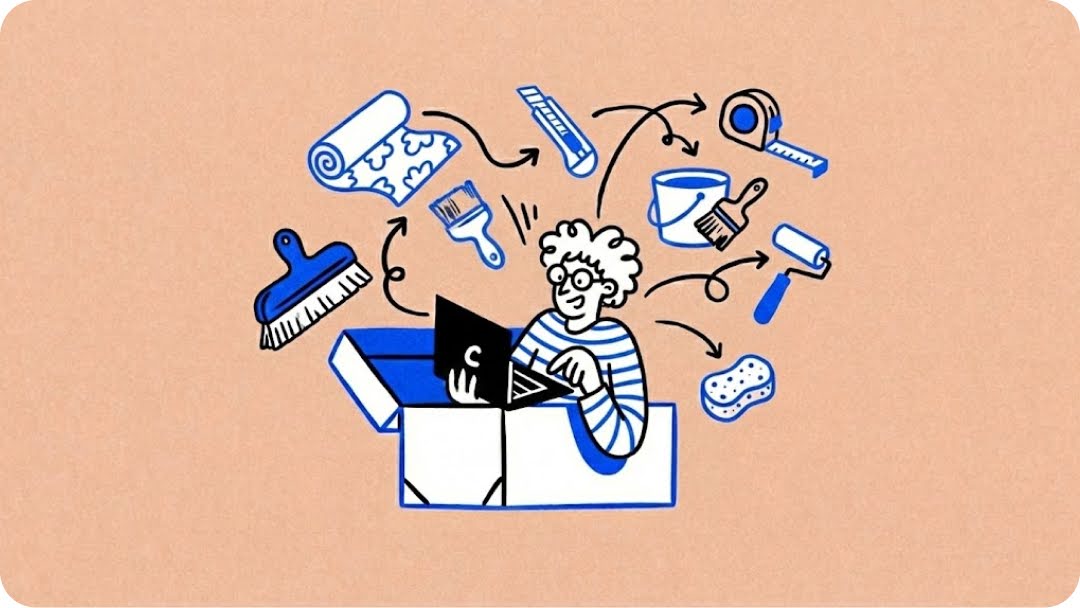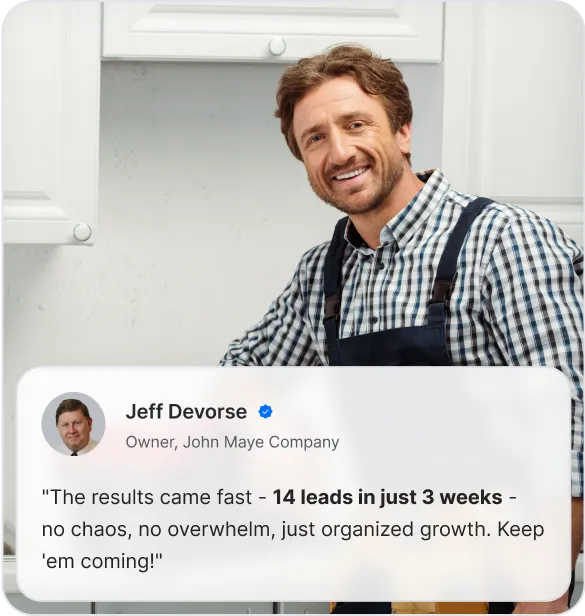Your line card isn't working. Not because it's bad, but because you're thinking about it wrong.
Most manufacturing companies treat their line card like a business card with product specs. They list what they make, throw in some technical details, and call it marketing. Meanwhile, their customers are drowning in a sea of identical-looking line cards from competitors who all claim to be "quality-focused" and "customer-driven."
Here's what's actually happening: At trade shows, in email attachments, on your website, it's doing the heavy lifting of explaining who you are and why someone should care. And right now, it's probably failing at that job.
This guide will show you exactly how to fix it.
TL;DR
- Most manufacturing line cards are product catalogs disguised as marketing. They list capabilities, specs, and certifications that mean nothing to prospects trying to solve problems. Buyers scan line cards for just 8 seconds at trade shows before deciding to keep or toss them.
- What works instead: Lead with your strongest differentiator in the first few seconds. Connect every capability to specific customer outcomes ("precision machining that prevents production shutdowns" vs "CNC services"). Include proof with real customer results, make it mobile-friendly and searchable online, and give clear next steps for interested prospects.
I. How a Line Card Impacts Your Business and What It’s Doing Right Now
Your line card is a crucial tool for nurturing leads who are already familiar with your company. It helps keep your brand top of mind and reinforces your value proposition after the initial interaction. However, if your line card doesn’t immediately communicate your value, it will fail to keep the lead engaged or move them closer to a decision.
Most line cards fail to perform this essential function. They’re often overly technical or filled with jargon that your leads may not easily relate to. Instead of nurturing, they become a missed opportunity to reinforce your strengths and differentiate you from competitors. So, how do you know if your line card is working for you or against you?
A. Quick Reality Check on Your Current Line Card
Pull out your current line card, physical or digital, and time yourself. Give yourself exactly 10 seconds to scan it, then answer these questions:
- What problem does this company solve?
- Why shou4ld I choose them over their competitors?
- What's their biggest strength or differentiator?
- How do I contact them if I'm interested?
If you can't answer all four questions clearly, neither can your customers. And if you can't do it in 10 seconds, you're losing prospects who scan even faster than you do.
Most manufacturing line cards fail this test completely. They're product catalogs disguised as marketing materials, full of internal jargon and technical specs that mean nothing to someone who doesn't already know your company.
B. Here's What's Really Happening
At trade shows, buyers spend about 8 seconds scanning each line card before deciding if it's worth keeping or tossing.
Online, they're comparing you to 5-10 other suppliers simultaneously, with your line card open in different browser tabs (if you do have digital line cards!). Your sales team is sending it to prospects who've never heard of you, hoping it explains why you're worth a phone call.
If your line card doesn't immediately communicate what you do and why it matters, you lose. The prospect moves on to the next supplier who does a better job of explaining their value.
The stakes are higher than you think. That line card isn't just marketing collateral, it's often your only shot at making a first impression. Mess it up, and you're not even in the running for the business.
C. How Modern Customers Actually Buy
The industrial buying process has completely changed, but most line cards haven't caught up.
Your customers aren't picking up the phone to ask basic questions anymore. They're doing their homework online first. By the time they contact you, they've already formed opinions about which suppliers are serious contenders and which ones aren't.
At trade shows, buyers collect line cards from every relevant supplier.
Back at the office, they spread them out on a conference table and start eliminating options. The line cards that clearly communicate value stay in the pile. The ones that don't get tossed.
Your line card gets forwarded to purchasing managers, engineers, and executives who've never met you. It needs to make sense to all of them, not just the person who originally picked it up.
If your line card isn't available online, easily shareable, and mobile-friendly, you're creating friction. Modern buyers expect instant access to information, not a request for someone to mail them something.
II. So, You Need to Change How You Think About Line Cards
A. Stop Making Lists, Start Solving Problems
The biggest mistake manufacturers make is treating their line card like a product catalog. Page after page of part numbers, specifications, and capabilities that make perfect sense to you but mean nothing to a prospect trying to solve a problem.
Here's why this happens: You know your products inside and out. You're proud of your capabilities, your equipment, your certifications. When someone asks what you do, your natural instinct is to list everything you can make. It feels comprehensive and professional.
But here's the disconnect:

When they see a list of services and specs, they have to do the mental work of figuring out if any of that actually helps them. Most won't bother.
Shift from listing features to showcasing how your product solves real problems. Highlight the benefits your product brings to the customer, not just the specs.
Instead of "CNC machining services with ±0.005" tolerance," try "±0.005" precision machining that keeps your production line running without quality issues."

Instead of "ISO 9001 certified facility with advanced equipment," try "ISO 9001 quality systems that ensure your parts meet spec every time, so you don't waste time on inspection delays."

Think like your customer. They have a problem: parts that don't fit, suppliers who miss deadlines, quality issues that shut down production. Your line card should immediately connect what you do to the problems they're trying to solve.
B. Differentiate with Proof
Claims without evidence are just marketing fluff. Your competitors probably say the same things about quality and service that you do. What makes you different is your ability to prove it.
Include customer success stories or results to back up your claims and make your company more credible. Real examples carry more weight than generic statements about excellence.
Instead of "We deliver on time," try "We helped ABC Manufacturing reduce their lead times from 6 weeks to 3 weeks, preventing a costly production shutdown."
Instead of "High-quality parts," try "Our precision components helped XYZ Corp reduce their reject rate from 8% to less than 1%."
Customer testimonials, case studies, photos of your work, and specific results give prospects confidence that you can deliver what you promise. They also help you stand out from competitors who only make claims without backing them up.
C. Think Digital, Not Just Paper
Trade shows aren't dead, but they're not the only game anymore. Your line card needs to work just as well on the screen as it does in a booth.
Customers expect to find information online instantly. Make your line card searchable, shareable, and always current.

Digital-first approach: Start with how your line card will look and function online, then adapt for print. This ensures it works on mobile devices, loads quickly, and can be easily shared via email or social media.
Always current: Digital line cards can be updated instantly. No more outdated contact information, discontinued products, or last year's certifications. Your line card should always reflect your current capabilities.
Searchable and shareable: If your line card lives online, it can be found by search engines and shared by customers. That's free marketing that works 24/7, not just during trade show season.
III. What Your Line Card Should Actually Do
Your line card has three jobs. If it's not doing all three, it's not working hard enough for your business.
A. Grab Attention Fast
You have seconds, not minutes. At trade shows, buyers are overwhelmed with options. Online, they're comparing multiple suppliers simultaneously. You need to communicate value immediately or lose them forever.
How to do it: Lead with your strongest differentiator. What makes you uniquely valuable? Is it your speed, quality, expertise, or innovative approach? Put that front and center, not buried on page two.
Test it: Remember the 10 second test? This time, show your line card to someone unfamiliar with your business and see if it is working.

B. Build Trust
Manufacturing relationships involve significant investments and long-term partnerships. Customers need confidence that you can deliver on your promises before they'll even consider getting a quote.
How to do it: Provide concrete proof of your capabilities:
- Customer success stories with specific results
- Photos of your actual work or facility
- Industry certifications and quality standards
- Years in business and key partnerships
- Performance metrics that matter to customers
What actually works: Real customer names (with permission), actual project results, and tangible evidence of your expertise. Generic statements about "quality and service" mean nothing. Specific proof builds credibility.
C. Make It Easy to Take the Next Step
Interested prospects shouldn't have to hunt for ways to contact you or figure out what to do next. Every piece of friction in your process sends customers to competitors who make it easier.
How to do it:
- Clear, prominent contact information
- Specific calls-to-action ("Get a quote," "Schedule a tour")
- Multiple contact methods (phone, email, online form)
- Quick response time commitments
- Simple process for moving from inquiry to proposal
The result: More qualified leads who know what they want and are ready to move forward.
IV. How to Actually Build a Better Line Card
A. Research Your Customers’ Needs
Before you write a single word, invest time understanding what your customers actually care about. Most manufacturers skip this step and wonder why their line card doesn't generate results.

B. Focus on Customer Solutions
We’ve discussed this, but it’s really important to take note of it again! Your line card should make it crystal clear what outcome they'll get from working with you.
The formula is simple: [Your capability] + [Customer outcome] = [Compelling message]
Examples that work:
- "24-hour turnaround machining for emergency repairs that get your line back up fast"
- "Food-grade stainless fabrication with full traceability documentation for FDA compliance peace of mind"
- "Prototype to production runs from 1 to 10,000 pieces, so you can test and scale without changing suppliers"
Notice each example includes both the technical capability AND the business outcome. This approach works because it helps prospects immediately understand if you're a fit for their specific situation.
C. Design for Impact
Mobile-first: Many customers will first see your line card on their phone. Make sure it's readable and functional on small screens.
Scannable layout: Use headings, bullet points, and white space so customers can find key information quickly.
Professional appearance: Your line card reflects the quality of your work. Poor design suggests poor attention to detail in manufacturing.
D. Go Digital
Online presence: Your line card should live on your website with its own URL that's easy to share and remember.
Search optimization: Include queries that customers use when searching for solutions like yours. (your marketing team can help you figure out exactly what these queries are, how many and which ones should you actually answer!)
Regular updates: Establish a schedule for reviewing and updating your line card. Outdated information kills credibility.
V. How to Know It's Actually Working
A. Your Sales Team Will Use It
Good signs:
- Salespeople reference it in customer meetings
- They send it to prospects without being reminded
- They ask for updates or additional versions
Warning signs:
- They create their own materials instead
- They avoid using it in presentations
- They complain it doesn't address customer questions
How to measure: Monthly check-ins with your sales team. Ask specifically what's working and what's missing.
B. Customers Will Respond Better
Good signs:
- More quote requests through your website
- Customers come to meetings already understanding your capabilities
- Shorter time between first contact and first meeting
- Higher quality leads who know what they want
Warning signs:
- Prospects ask basic questions that should be answered in your line card
- You're getting inquiries from unqualified leads who aren't a good fit
- Customers seem confused about what you actually do
How to measure: Track website analytics for your line card page, monitor quote request volume and quality, survey new customers about their research process
C. Your Business Will See Results
Good signs:
- Shorter sales cycles
- Higher conversion rates from leads to customers
- Increased average project size
- Better customer retention
Warning signs:
- Sales cycles are getting longer, not shorter
- You're competing mainly on price instead of value
- Win rates are declining despite more activity
- Customers keep asking for references from similar projects
How to measure: Track time from first contact to signed contract, monitor lead-to-customer conversion rates, analyze revenue per customer trends
VI. Practical Steps to Get Started This Month
Week 1: Figure Out What You Have Now
Day 1: Collect all current versions of your line card (print, digital, variations by different team members)
Day 2: Review your website analytics to see how people currently find and interact with your company information
Day 3: Survey your sales team about what works and what doesn't with current materials
Day 4: Analyze 5 competitors' line cards or marketing materials
Day 5: Rate your current line card 1-10 for grabbing attention, building trust, and making next steps clear
Week 2: Fix the Biggest Problems
Day 1: Identify the top 3 issues with your current line card
Day 2 & 3: Rewrite your value proposition to focus on customer problems, not your capabilities
Day 4: Gather proof elements (customer stories, photos, results) that build credibility
Day 5: Simplify your contact information and calls-to-action
Week 3: Make It Look Professional
Day 1: Create a clean, scannable layout with clear hierarchy
Day 2: Ensure all text is readable and jargon-free
Day 3: Add quality images that support your message
Day 4: Test the design on desktop and mobile devices
Day 5: Proofread everything and get team feedback
Week 4: Get It Online and Working
Day 1: Upload your line card to your website with a dedicated URL
Day 2 Optimize for search engines with relevant keywords
Day 3: Set up tracking to measure performance
Day 4: Train your sales team on the new version
Day 5: Share with current customers for feedback
VII. Common Mistakes That Kill Line Card Effectiveness
A. Making It About You Instead of Your Customer
The mistake: Leading with your company history, your equipment, your achievements, your processes.
Why it fails: Customers care about their problems, not your company.
The fix: Start every section with customer benefits.
B. Using Internal Language Customers Don't Understand
The mistake: Technical jargon, internal product codes, industry acronyms without explanation.
Why it fails: Confusion kills sales.
The fix: Write for your customer's level of technical knowledge, not your own.
C. Forgetting to Update It
The mistake: Creating a line card once and using it for years without changes.
Why it fails: Outdated information destroys credibility.
The fix: Schedule quarterly reviews.
VIII. Is Your Line Card Really the Problem?
Here's the honest truth: Your line card might just be a symptom of a bigger issue.
If you're reading this guide because leads aren't converting, sales cycles are too long, or you're losing to competitors on price, your line card is probably part of the problem. But it might not be the whole problem.
The Real Questions You Need to Ask
Are prospects finding you in the first place? If your phone isn't ringing and your website isn't generating inquiries, the best line card in the world won't help. You have a visibility problem, not a conversion problem.
Do you understand what your customers actually value? If you can't clearly articulate why someone should choose you over cheaper alternatives, you have a positioning problem that goes deeper than marketing materials.
Is your entire sales process aligned? If your line card promises one thing but your sales team presents differently, or your website says something else entirely, you have a consistency problem across your entire go-to-market approach.
When to Fix It Yourself vs. When to Get Help
Fix it yourself if:
You're getting leads but they're not converting. Your visibility is fine, you just need better sales materials. A line card makeover should fix this bottleneck.
Your sales team knows your value proposition. If your best salespeople can explain why customers choose you, you have what you need. Just capture that knowledge in your line card.
It's mainly a messaging problem. You know what makes you different, you just need to present it better. Maybe a writer can help, but major outsourcing won’t be required.
Consider getting professional help if:
Prospects can't find you. No line card will help if customers don't know you exist. You need a comprehensive strategy to get found online.
You can't explain what makes you different. If you're not clear on your unique value, your line card won't be either. This requires positioning work that goes beyond copywriting.
Everything feels scattered. When your website, line card, and sales team all say different things, you need someone to orchestrate a cohesive system.
You'd rather focus on your business. Building an effective marketing system requires ongoing attention. If you'd rather spend time on operations and customers, get experts to handle marketing.
Most manufacturers try to fix these problems one at a time. They update the line card, then the website, then try advertising. What works better is building a complete system where everything works together.
Your Next Steps (Don’t Wait!)
Before you dive into redesigning your line card, take an honest look at your entire sales and marketing approach. Is your line card the real bottleneck, or is it just the most obvious symptom?
If you're ready to build a complete system that gets you found, trusted, and chosen, we'd be happy to show you how other manufacturers have done exactly that. Connect with our team to discuss your specific situation.
If you just need to fix your line card first, start with the 10-second test and work through the practical steps in Section VI. Either way, don't let another month pass with a line card that's working against you instead of for you.






















.webp)








.webp)
.svg)


.svg)
.svg)
.svg)




.svg)





.svg)